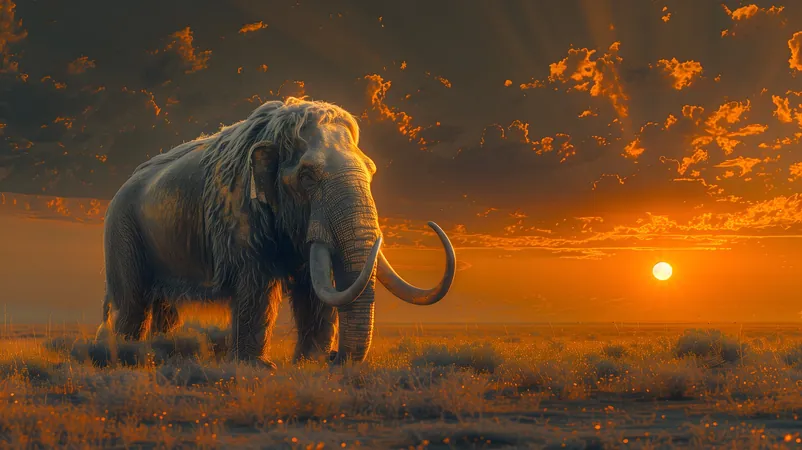
Unlocking the Secrets of Extinct Giants: New Fossil Markers Reveal Australia’s Megafauna
2025-06-03
Author: Arjun
What caused the extinction of the majestic megafauna? From colossal moas to mighty mammoths, many large species vanished over the last 10,000 years, leaving a puzzle for scientists eager to understand prehistoric ecosystems and prevent future extinctions. Fossils often lack clear identifiers, and in many cases, DNA recovery from ancient bones is nearly impossible, especially in warmer climates.
Revolutionary Discoveries in Collagen Peptide Markers
Thanks to groundbreaking research, scientists have now isolated collagen peptide markers that can accurately identify three iconic Australian megafauna: a wombat the size of a hippopotamus, a giant kangaroo, and a clawed marsupial unlike any seen today.
"The geographic range and extinction timeline of Australia’s megafauna, along with their interactions with early modern humans, remain hot topics of debate," explained Professor Katerina Douka from the University of Vienna, who led the research published in *Frontiers in Mammal Science*.
Solving the Puzzle of Past Extinctions
Notably, the scarcity of fossil finds makes it challenging to test theories regarding these extinctions. Dr. Carli Peters, the study's lead author from the University of Algarve, emphasized that new methods like Zooarchaeology by mass spectrometry could vastly improve the identification of megafauna remnants, provided these collagen markers are available.
The Power of Peptides in Ancient Bones
By analyzing peptides, scientists can distinguish between different genera and sometimes species of animals. This method excels in tropical and sub-tropical regions where DNA may not survive. Historically, most reference markers pertained to Eurasian species, but this recent work enhances Australia’s fossil records by developing new, relevant markers.
According to Peters, "Proteins tend to preserve better over longer periods and harsher conditions compared to DNA. In the context of megafauna extinctions, proteins could still offer clues where DNA has degraded beyond recovery."
Meet the Legendary Megafauna
The researchers focused on three remarkable species: Zygomaturus trilobus, Palorchestes azael, and Protemnodon mamkurra. Z. trilobus was one of the largest marsupials ever, resembling a hippo-sized wombat. P. azael was a unique marsupial with a long tongue and towering claws. Meanwhile, Protemnodon, a giant kangaroo, had a fascinating evolutionary design that allowed for quadrupedal movement.
As Dr. Richard Gillespie revealed, some of these bones date back beyond 43,000 years, suggesting these creatures might have overlapped with the arrival of early modern humans in Tasmania.
Identifying the Ghosts of the Past
The research team meticulously ruled out contaminants and matched the peptide markers to existing references. They successfully distinguished Protemnodon from both living and extinct kangaroo genera and identified Zygomaturus and Palorchestes among other large marsupials.
However, the differentiation between species may require further research, as collagen changes accumulate very slowly over time.
A New Hope for Paleontology
The potential to distinguish genera from more temperate regions opens the door to identifying bones found in tropical areas, where related species might have existed side-by-side. As Peters states, utilizing these new collagen peptide markers could significantly expand our knowledge of Australia’s ancient megafauna. This groundbreaking discovery marks a pivotal step in reconstructing the ecological narratives of a long-lost era.


 Brasil (PT)
Brasil (PT)
 Canada (EN)
Canada (EN)
 Chile (ES)
Chile (ES)
 Česko (CS)
Česko (CS)
 대한민국 (KO)
대한민국 (KO)
 España (ES)
España (ES)
 France (FR)
France (FR)
 Hong Kong (EN)
Hong Kong (EN)
 Italia (IT)
Italia (IT)
 日本 (JA)
日本 (JA)
 Magyarország (HU)
Magyarország (HU)
 Norge (NO)
Norge (NO)
 Polska (PL)
Polska (PL)
 Schweiz (DE)
Schweiz (DE)
 Singapore (EN)
Singapore (EN)
 Sverige (SV)
Sverige (SV)
 Suomi (FI)
Suomi (FI)
 Türkiye (TR)
Türkiye (TR)
 الإمارات العربية المتحدة (AR)
الإمارات العربية المتحدة (AR)